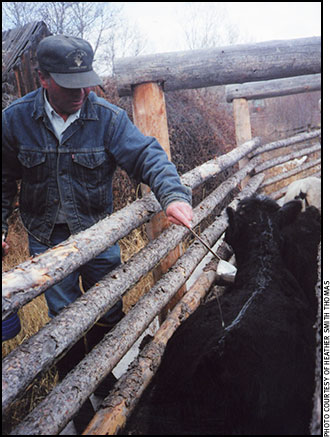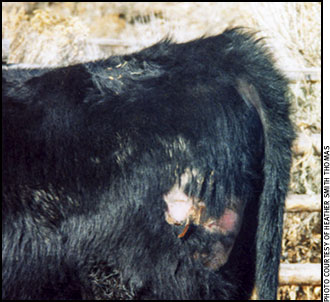Controlling Lice
Tips for choosing the right delousing products for the cow herd.
Greg Johnson, veterinary entomologist, Montana State University, says there are three species of sucking lice in most cattle-producing states and one species of biting/chewing louse.

Pyrethroids kill external parasites like adult and immature lice on contact. According to the label, pyrethroid products should be applied twice to get the lice that hatch out from eggs after the first treatment.
“Many producers treat cattle in the fall; the animals either get injected or poured with one of the avermectins, including ivermectin or generics: moxidectin, doramectin or eprinomectin. Because these products are systemic, they control most internal and external parasites. The injectable avermectins will control the blood-sucking lice but not the biting louse,” he says.
The long-nosed louse and the short-nosed louse populations peak earlier in the fall than the others, so fall treatments are usually effective against them.
“The little blue louse is another sucking species, but their population and the biting/chewing louse don’t peak until January or later. This might explain why cattle may become very lousy mid-winter even after being poured in the fall. Some of the cattle I’ve looked at were infested with biting lice,” says Johnson.
These lice are very irritating. They crawl through the hair, feed on the skin and cause itching. “Cattle with biting lice look unthrifty and are very miserable,” he says.
“One of our concerns is how to handle late-winter populations. I recommend a synergized pyrethroid pour-on, such as Ultra Boss, Synergized DeLice, Ultra Saber or other trade names, which contain a pyrethroid plus the synergist piperonyl butoxide. The synergist is not toxic to lice but extends lethal activity of the pyrethroid. Pyrethroid insecticides are not systemic; they don’t kill internal parasites.”
Pyrethroids kill external parasites like adult and immature lice on contact. According to the label, pyrethroid products should be applied twice to get the lice that hatch out from eggs after the first treatment.
“None of them kill the eggs,” Johnson says.
“The only product I am aware of that will control adults, immature lice and the eggs is called Clean-Up II. It contains permethrin (a pyrethroid) plus it has diflubenzuron, which is an insect growth regulator,” he said. “Since it’s a single application, this is much handier for producers since it can be difficult to treat the animals twice during the winter.”

These lice are very irritating. They crawl through the hair, feed on the skin and cause itching. “Cattle with biting lice look unthrifty and are very miserable,” Greg Johnson says.
There are also other products labeled to control lice, including dust bags, oilers or insecticide ear tags labeled for lice, as well as fly control.
Johnson says he has heard producers say that some of the products are not as effective as they used to be.
“There have been reports of pyrethroid-resistant lice in the UK and Australia, but I am not aware of any documented cases of lice resistance to products we use here. However, we have been using some of these products for more than 15 years, so I always encourage producers to rotate those chemicals. Even though there are some similarities in their mode of action, we should try to delay any resistance, just as we have to do with horn flies,” he says.
If cattle get underdosed in the fall, some lice survive and their numbers increase in January or February.
“Perhaps another explanation would be a concentration gradient of the insecticide when pouring cattle; the concentration might be heavier along the topline and lighter down along their sides. Lice may survive where the lighter concentration occurs and reinfest the animal.”
There are also some animals in the herd that seem more susceptible to lice and always have higher numbers, serving as a source of lice to transmit to other cattle. “If a producer can identify those individuals, the best thing to do is cull them, because you can never seem to get all the lice off them. They reinfest the herd,” he says.
“In the fight against lice during winter, it also helps to feed high-energy diets to help reduce cold stress. When cattle get stressed, the lice increase. They do better on a stressed animal than a healthy animal; the stressed animal has a compromised immune system, and the lice take advantage of that,” explains Johnson.
“I would like to see research programs investigating the timing of insecticide applications for lice control, so we can learn more about how the different species of lice are responding to treatments and whether they are developing resistance to delousing products,” he says.

Editor’s Note: Heather Smith Thomas is a freelance writer and cattlewoman from Salmon, Idaho.






